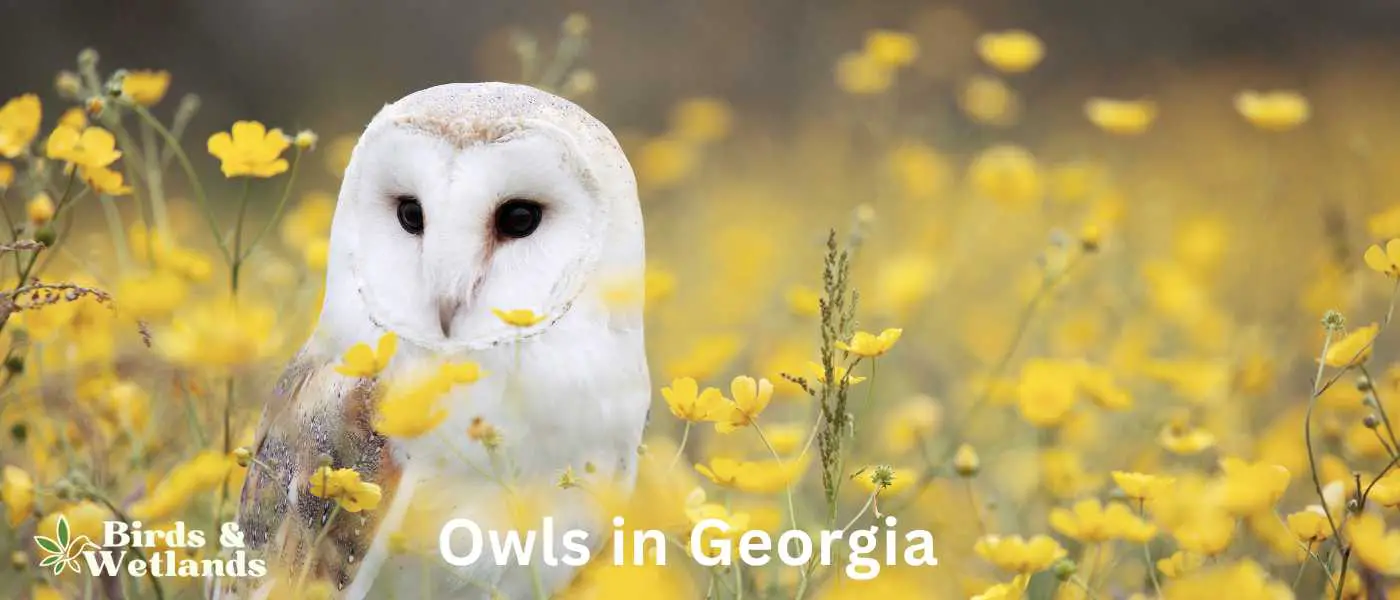Nestled within the diverse landscapes of Georgia, from the verdant Appalachian Mountains to its lush coastal plains, resides a compelling assortment of owls. These night-time birds of prey hold an essential position within Georgia’s biodiversity, acting as powerful hunters and important components in their ecological communities.
Georgia Owls
| Owl Species | Frequency in Georgia | Presence in Georgia | Specific Locations in Georgia |
|---|---|---|---|
| Great Horned Owl | High | Statewide | Chattahoochee River National Recreation Area, Sandy Springs; Stone Mountain Park, Stone Mountain |
| Barred Owl | High | Statewide | Okefenokee Swamp Park, Waycross; Cohutta Wildlife Management Area, Chatsworth |
| Eastern Screech Owl | High | Statewide | Piedmont Park, Atlanta; Skidaway Island State Park, Savannah |
| Barn Owl | Moderate | Across Georgia, primarily in Open Fields | Harris Neck National Wildlife Refuge, Townsend; Flint RiverQuarium, Albany |
| Northern Saw-whet Owl | Low (Seasonal) | Northern Georgia in Winter | Brasstown Bald, Blairsville; Unicoi State Park, Helen |
| Short-eared Owl | Low | Open Fields and Grasslands | Paulding Forest Wildlife Management Area, Dallas; Oconee National Forest, near Greensboro |
| Long-eared Owl | Very Low | Scattered Across State | Sweetwater Creek State Park, Lithia Springs; Chattahoochee Nature Center, Roswell |
| Burrowing Owl | Very Low | Rare, occasionally sighted | Jekyll Island; Coastal Georgia Botanical Gardens, Savannah |
| Snowy Owl | Very Rare | Rare | Mostly sighted in northern Georgia during severe winters |
Owl Species Found in Georgia
Great Horned Owl (Bubo virginianus)

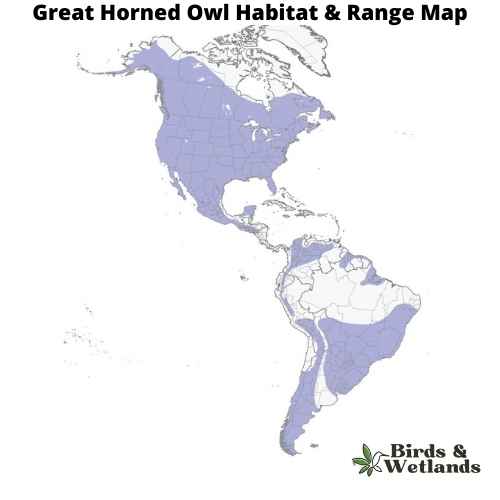
Great Horned Owl Sound
Scientific Name:Bubo virginianus
Length: 18.1-24.8 in
Wingspan: 39.8-57.1 in
Weight: 32.1-88.2 oz
The Great Horned Owl is a large owl with long wings and a large head. It’s one of the most common owls in North America.
Great Horned Owls are large, stocky birds with soft feathers that are gray to brown on their backs and white on their chests. Their faces are characterized by two black “ear” tufts, which can be raised or flattened depending on the owl’s mood. The eyes are yellow, orange, or red in color.
The habitat of the Great Horned Owl is a variety of different environments such as forests and deserts. They also live near water sources such as lakes, streams and rivers where they can hunt for fish.
The diet of the Great Horned Owl consists primarily of small mammals such as mice and rats; however they will also eat other rodents such as squirrels, rabbits and porcupines. They have been known to eat skunks too.
Eastern Screech-Owl (Megascops asio)
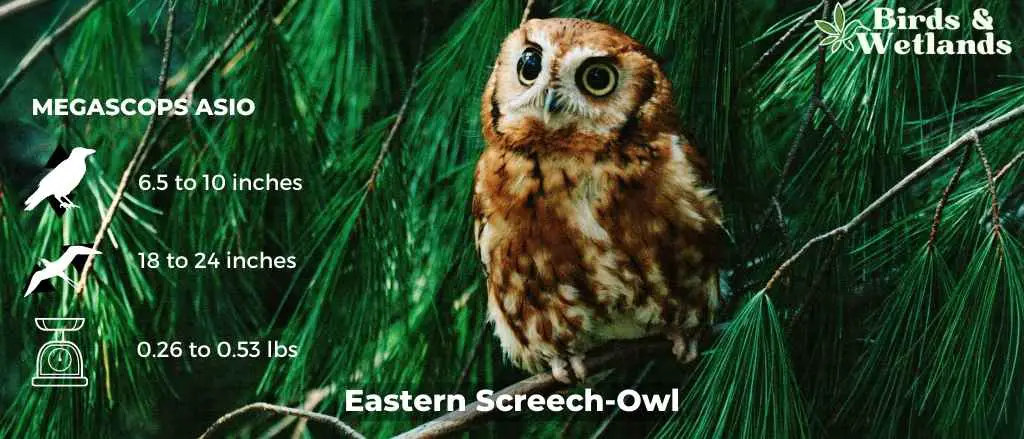
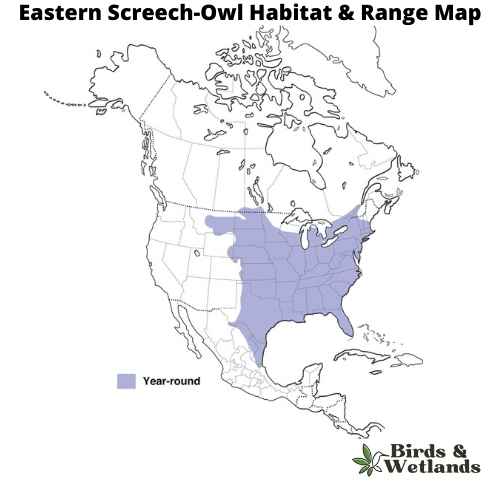
Eastern Screech-Owl Sound
Scientific Name: Megascops asio
Length: 6 to 10 in
Wingspan: 8 to 24 in
Weight: 4 – 8.5 oz
The Eastern Screech-Owl is a small owl species native to most wooded environments of the eastern half of North America, from the Canadian provinces to Florida and Texas.
Eastern Screech-Owls are relatively small and exhibit a complex pattern of gray or reddish-brown coloration, which provides excellent camouflage against tree bark.
These owls are known for their distinctive call, which is often described as a haunting trill or a whinny-like sound. Despite their name, they do not actually produce a “screech.”
Eastern Screech-Owls feed on a variety of prey, ranging from small mammals and birds to insects and even earthworms. It is primarily nocturnal, hunting at night from a low perch and swooping down onto prey.
Eastern Screech-Owls nest in tree cavities or abandoned woodpecker nests, but they readily adapt to nesting boxes where natural cavities are not available. They typically lay between 2 to 6 eggs, which are incubated primarily by the female.
Barred Owl (Strix varia)

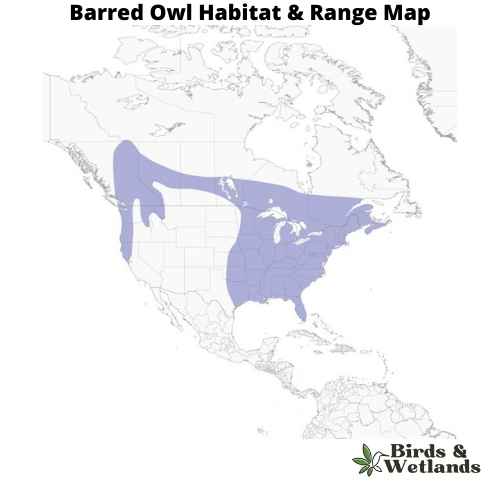
Barred Owl Sound
Scientific Name: Strix varia
Length: 40 to 63 cm (16 to 25 in)
Wingspan: 96 to 125 cm (38 to 49 in)
Weight: 468 to 1,150 g
The Barred Owl is a medium-sized owl with a barred pattern on its chest and belly. They have large yellow eyes that allow them to see well in low light conditions. Their ears are not very large which means they do not hear very well but they have excellent hearing abilities which allow them to detect sounds up to 1 mile away. Their feathers are brown and streaked with white, and they have black bars on their chests and wings.
Their habitats include forests, woodlands, orchards, parks, farmland and suburban backyards.
Barred Owls (also known as hoot owl) eat small mammals such as mice, rats and squirrels. They also eat insects such as beetles or grasshoppers. These owls hunt during the day when it is light out so that they can see their prey better than at night when they would be using senses other than sight like sound or smell to find their food source.
Barred owls are monogamous birds which means they mate for life. They build nests in trees or cavities on the ground and lay 2-4 eggs per year. The incubation period for these eggs lasts about 28 days before hatching takes place.
Barn Owl (Tyto alba)

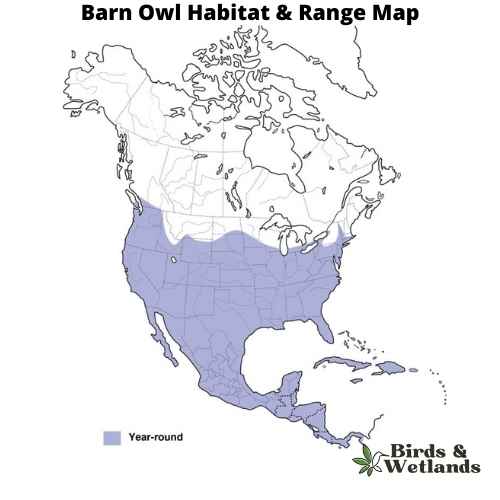
Barn Owl Sound
Scientific Name: Tyto alba
Length: 13 to 15 in
Wingspan: 31 to 37 in
Weight: 9.2 oz
The Barn Owl is a widespread species of owl known for its distinctive heart-shaped facial disc.
Barn Owls are medium-sized owls, they are pale overall with golden-brown wings and back, contrasted by a white face, chest, and belly. Their most notable feature is their heart-shaped facial disc, which helps channel sound to their ears.
Barn Owls are typically found in open habitats, including farmland, woodland, and marshes. They are named for their habit of nesting in human structures such as barns, church towers, and in the hollows of large trees. These owls are nocturnal, hunting at night and roosting during the day.
The diet of Barn Owls primarily consists of small mammals, particularly rodents such as mice and rats. They are known for their silent flight, which allows them to sneak up on their prey without detection.
Barn Owls have a unique nesting behavior. They do not build nests, but instead, lay their eggs directly on the bare surface of a secluded ledge or cavity. A female typically lays 4-7 eggs, and both parents help incubate the eggs and care for the chicks.
Short-eared Owl (Asio flammeus)
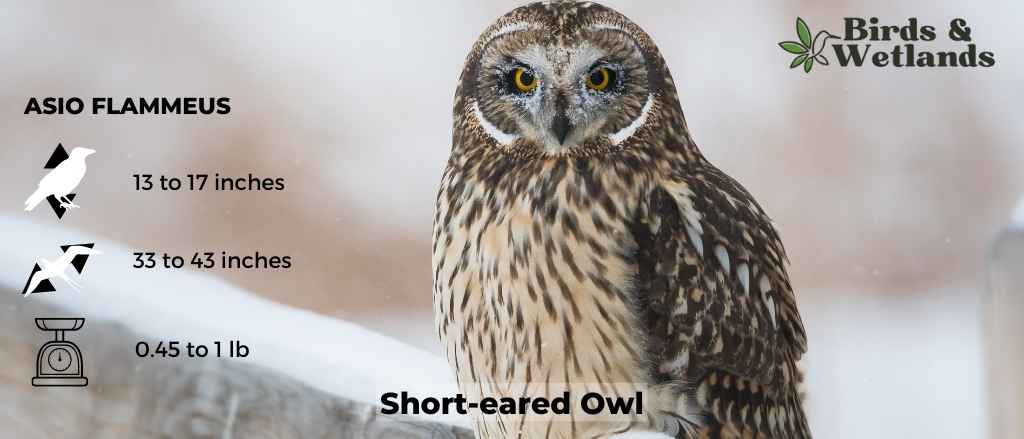
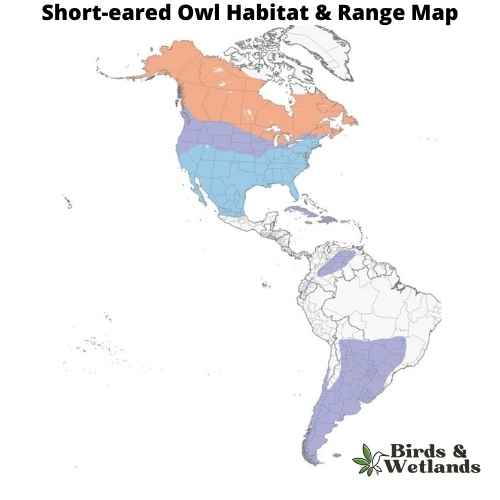
Short-eared Owl Sound
Scientific Name: Asio flammeus
Length: 13–17 in
Wingspan: 33 to 43 in
Weight: 7.3–16.8 oz
The Short-eared Owl is a medium-sized owl species with a wide distribution, found across North and South America, Europe, Asia, and many Pacific islands. Despite its name, the “ears” of the Short-eared Owl are not often visible, as they are small and tend to blend with the bird’s feathers.
The owls are predominantly brown with buff and white accents throughout their body and wings, and dark patches around their yellow eyes.
Short-eared Owls diet consists largely of small mammals, especially voles. However, they are opportunistic hunters and will also prey on a variety of other animals, including other birds, when available.
Their habitat is characterized by open areas like grasslands, marshes, and tundra. They nest on the ground, which is unusual for owls, and this makes them vulnerable to ground predators. As such, they often live in areas with tall grasses or other ground cover for protection.
Northern Saw-whet Owl (Aegolius acadicus)
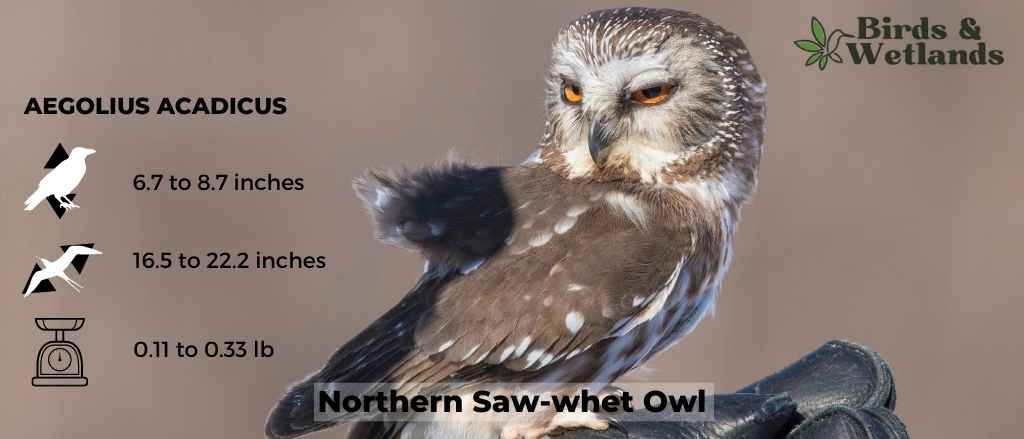
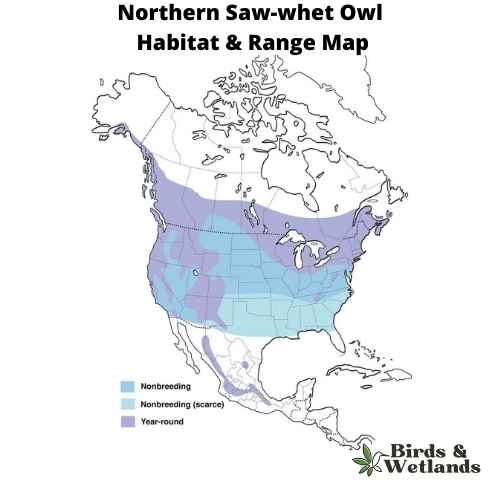
Northern Saw-whet Owl Sound
Scientific Name: Aegolius acadicus
Length: 17–22 cm (6.7–8.7 in)
Wingspan: 42–56.3 cm (16.5–22.2 in)
Weight: 54 to 151 g (1.9 to 5.3 oz)
The Northern Saw-whet Owl is a tiny, speckled gray owl and it’s one of the smallest owls in North America. It’s also known as the Little Owl or Wood Owl in some areas.
Northern Saw-whet Owls have dark brown eyes, white eyebrows, and yellow beak. It has brownish-grey feathers that are spotted with white. The owl’s legs are covered in feathers and appear nearly invisible when the bird is perched on a branch or tree.
In the winter they migrate south to warmer climates. They prefer to live in dense coniferous forest with large trees but will occasionally nest in shrubs or other vegetation that can protect them from predators.
The Northern Saw-whet Owl eats mice and voles (small rodents), small birds, frogs, salamanders, moles and shrews, but unlike most owls they chop their prey up and spread over a few meals. They will also eat insects like beetles and grasshoppers if they are available. It hunts from a perch at night using its excellent hearing to locate prey items within about 30 feet (9 meters) of its nest.
These owls nest in tree cavities usually located close to water sources such as lakes or rivers where they can find their food source (insects). They lay 2-4 eggs at one time which incubate for about 30 days before hatching.
The long-eared owl (Asio otus)
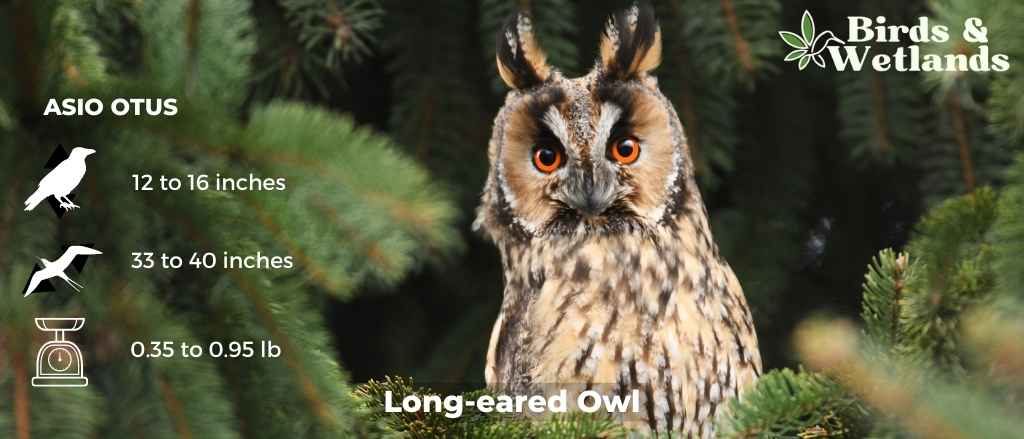
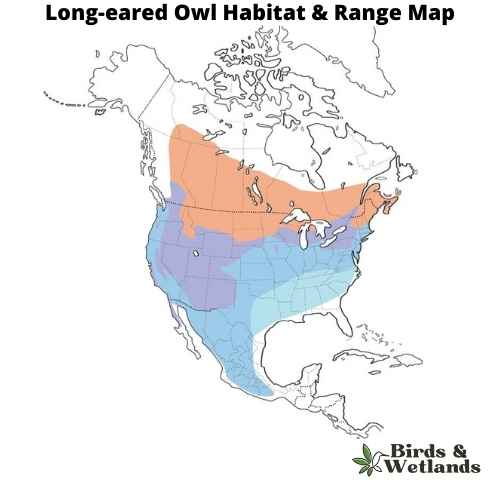
Long-eared Owl Sound
Scientific Name: Asio otus
Length: 12 and 16 in
Wingspan: 2 ft 10 in to 3 ft 4 in
Weight: 5.6 to 15.3 oz
The Long-eared Owl is a medium-sized owl species known for its distinctively long ear tufts, which can be raised or lowered depending on the bird’s mood or intention.
Long-eared Owls have mottled brown and cream plumage, which provides excellent camouflage among the trees. Their most distinctive features are their long, black-tipped ear tufts, which are set closer to the center of the head than in most other owl species.
These owls inhabit a wide variety of habitats, including deciduous and coniferous forests, woodlands, and even semi-deserts.
The Long-eared Owl’s diet primarily consists of small mammals, especially voles, but they will also take small birds and insects. They are skillful hunters, often capturing prey from a perch or in flight.
In terms of nesting behavior, Long-eared Owls do not construct their own nests, instead they take over old nests built by other bird species, usually those of corvids or other large birds. They lay an average of 4 to 5 eggs, which are incubated by the female while the male provides food.
Burrowing Owl (Athene cunicularia)
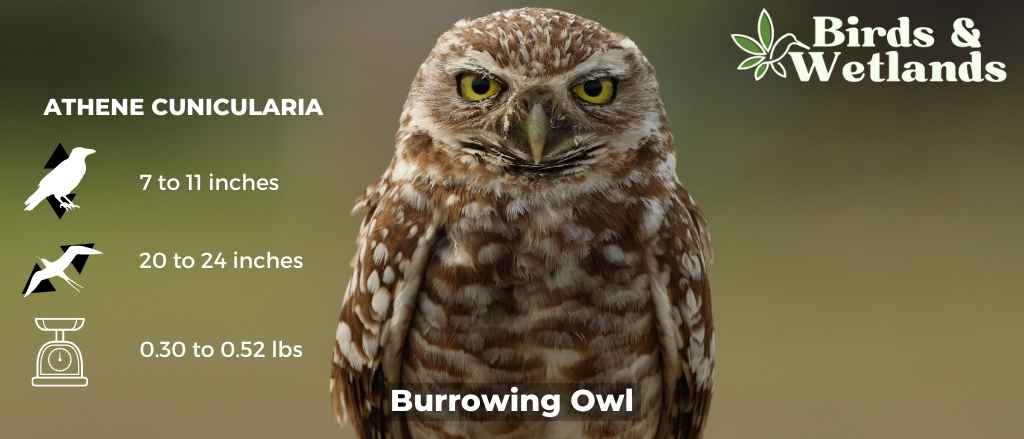
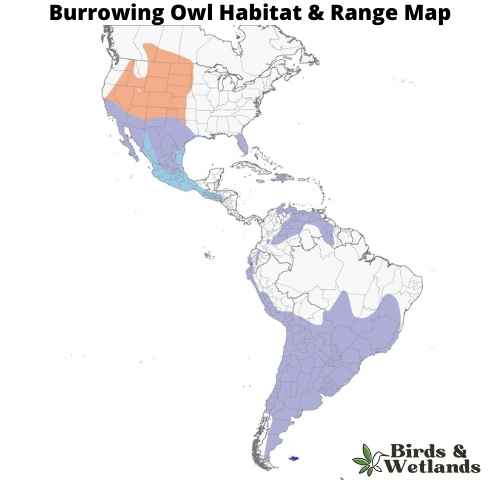
Burrowing Owl Sound
Scientific Name: Athene cunicularia
Length: 7–11 in
Wingspan: 20–24 in
Weight:5–8 oz
The Burrowing Owl is a small, long-legged species of owl found in North and South America. Known for its unusual habit of living in burrows in the ground.
Burrowing Owls have a rounded head with no ear tufts and bright yellow eyes. Their overall coloration is mottled brown and white with a distinct white “eyebrow” above each eye.
Their primary habitat includes open landscapes such as grasslands, deserts, agricultural areas, golf courses, and even airports. As their name suggests, these owls often reside in burrows, many of which are abandoned by prairie dogs, ground squirrels, or other burrowing animals. In some cases, they may also dig their own burrows.
Burrowing Owls diet consists mainly of small mammals and insects, but they also eat birds and reptiles.
Burrowing Owls have a unique nesting behavior. They lay their eggs in an underground burrow to protect them from predators and extreme weather. Clutch sizes range from 6 to 11 eggs, which are incubated for about a month before hatching.
Snowy owl (Bubo scandiacus)
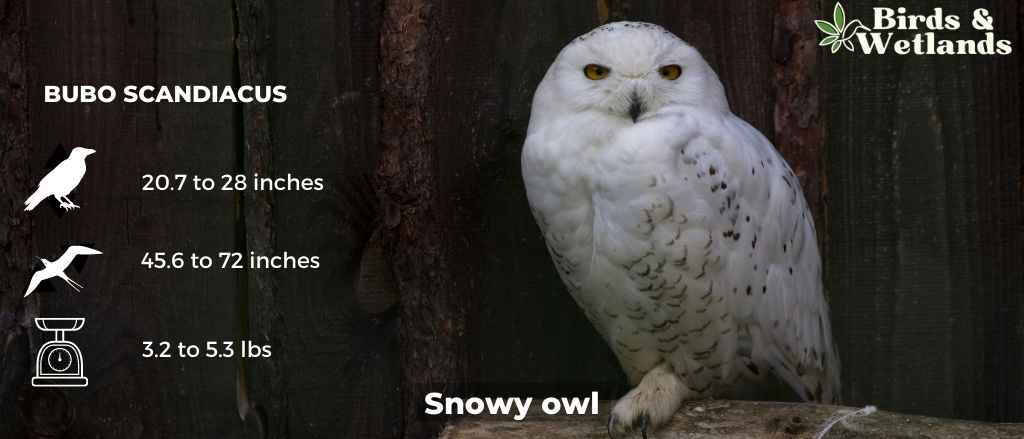
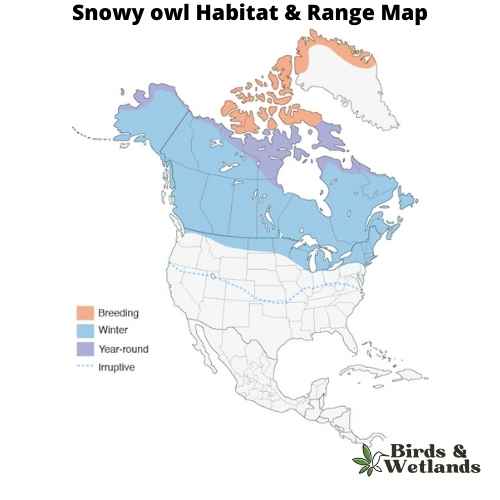
Snowy owl Sound
Scientific Name: Bubo scandiacus
Length: 20.7 to 28 in
Wingspan: 3 ft 10 in to 6 ft 0 in
Weight: 3.2lb to 5.3lb
The Snowy Owl, is of the most well-known species of owls, the Snowy Owl is renowned for its striking appearance and adaptations to its extreme environment.
Snowy Owls are medium sized birds that possess a rounded head, yellow eyes, and a black beak. The most distinctive feature of the Snowy Owl is its white plumage, which provides effective camouflage in its snowy habitat. Male Snowy Owls are often almost completely white, while females and younger owls have more extensive dark barring on their plumage.
Unlike many owl species, Snowy Owls are primarily diurnal, which means they are active during the day. This is an adaptation to life in the Arctic, where there can be 24 hours of daylight in the summer. Their diet mainly consists of small mammals, particularly lemmings, but they are known to eat a variety of animals including birds, fish, and even carrion when necessary.
Snowy Owls nest on the ground, usually on a mound or boulder. Their breeding success is closely tied to the availability of food, and in good years a single pair of owls can raise a large brood of chicks.
Where to Spot Georgia’s Owls
Cohutta Wildlife Management Area: Nestled in the Chattahoochee National Forest, this location is home to a variety of owl species, including Great Horned Owls, Barred Owls, and Eastern Screech Owls. Its rich and varied wilderness provides ideal habitats for these species.
Chattahoochee River National Recreation Area, Atlanta: This national recreation area in the metro Atlanta region is a great place to spot several owl species, including Barred Owls and Great Horned Owls, without having to venture too far out of the city.
Okefenokee National Wildlife Refuge: This expansive swamp is home to the Barred Owl, which thrives in its watery environment. Their unique, haunting calls echo through the swamp, making them easier to locate.
Jekyll Island: During the winter months, this coastal island can be a good place to spot migrating owl species. The island’s diverse habitats – from maritime forests to salt marshes and beaches – attract a variety of birds.
Kennesaw Mountain National Battlefield Park: This historical park near Marietta offers a diverse landscape that attracts a variety of birds, including several owl species. Birdwatchers have reported sightings of Eastern Screech Owls, Great Horned Owls, and Barred Owls.
| State | Main Owl Watching Sites |
|---|---|
| Georgia Owls | Okefenokee National Wildlife Refuge, Piedmont Park in Atlanta |
| Florida Owls | Everglades National Park, Corkscrew Swamp Sanctuary |
| Alabama Owls | Wheeler National Wildlife Refuge, Bankhead National Forest |
| Tennessee Owls | Great Smoky Mountains National Park, Radnor Lake State Park |
| North Carolina Owls | Alligator River National Wildlife Refuge, Pisgah National Forest |
| South Carolina Owls | Congaree National Park, Francis Beidler Forest |
Tips on How to Spot Owls in Georgia?
Know Your Owls: In Georgia, you can find several species of owls including the Great Horned Owl, Barred Owl, Eastern Screech Owl, and occasionally the Short-eared Owl and Northern Saw-whet Owl. Each has different habitat preferences and behaviors.
Choose the Right Time: As with most places, the best time to spot owls in Georgia is during the early morning hours or at dusk, as many owl species are crepuscular. However, some species such as the Barred Owl can also be active during the day.
Select the Right Location: Different owls prefer different habitats. For example, Great Horned Owls can be found in a variety of settings from rural to suburban areas, whereas Barred Owls are often seen near rivers and wetlands. Researching each species’ preference can increase your chances of spotting them.
Listening for Calls: Knowing the sounds that different owl species make can be very useful. For example, the Eastern Screech Owl has a distinctive trilling call, while the Barred Owl is known for its “who cooks for you” call. Listening for these sounds can help you locate the owls.
Look for Signs: Keep an eye out for signs of owl activity. This can include nests in tree cavities or on ledges, owl pellets on the ground, or white droppings on the trunks of trees.
Equipment: A pair of good-quality binoculars will be very useful when owl spotting. Using a headlamp with a red light is also helpful as it is less likely to disturb the owls.
Join a Bird Watching Group: Consider joining a local birding group or participating in an organized owl prowl. Experienced birders can provide helpful advice and share their knowledge about where owls have been recently spotted.
Be Respectful: Remember to keep a respectable distance from the owls and their nesting sites. If an owl appears disturbed or agitated by your presence, it’s best to move away.

